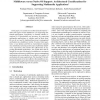Free Online Productivity Tools
i2Speak
i2Symbol
i2OCR
iTex2Img
iWeb2Print
iWeb2Shot
i2Type
iPdf2Split
iPdf2Merge
i2Bopomofo
i2Arabic
i2Style
i2Image
i2PDF
iLatex2Rtf
Sci2ools
RTAS
2002
IEEE
2002
IEEE
Middleware versus Native OS Support: Architectural Considerations for Supporting Multimedia Applications
In this paper, we examine two architectural alternatives— native OS support versus middleware—for supporting multimedia applications. Specifically, we examine whether extensions to OS functionality are necessary for supporting multimedia applications, or whether much of these benefits can be accrued by implementing resource management mechanisms in a middleware system. To answer these questions, we use QLinux and TAO as representative examples of a multimedia operating system and a multimedia middleware, respectively, and examine their effectiveness in supporting distributed applications. Our results show that although the run-time overheads of a middleware can impact application performance, middleware resource management mechanisms can, nevertheless, be as effective as native OS mechanisms for many applications. We also find OS kernelbased mechanisms to be more effective then middleware systems at providing application isolation and at preventing applications from interfering...
| Added | 15 Jul 2010 |
| Updated | 15 Jul 2010 |
| Type | Conference |
| Year | 2002 |
| Where | RTAS |
| Authors | Prashant J. Shenoy, Saif Hasan, Purushottam Kulkarni, Krithi Ramamritham |
Comments (0)

